Behind the Numbers: Commencal Meta TR 29
Behind the Numbers made possible by Creaform Portable 3D Measurement Technologies
Behind the Numbers is back!
If you’d like to know more about the Behind the Numbers series, aren’t familiar with the terms being used or want to know why the hell we’re doing, this then head back to out our introduction article for that.
We’re also trying to take certain terms and set about explaining them, how they might be analysed and add some food for thought by re-inserting the violently chaotic real world in which we ride back into the analysis. Recently we touched on anti-squat, but look out for more of the Enginerding articles in the future.
But, we’re back for another round of bikes and this time we’re looking at the vast category of trail bikes. There’s quite some discussion as to what a trail bike is. Our recent podcast did just that with differing opinions on the boundaries of trail bike in terms of travel, geometry and bike intent. We’ve tried to take a good sampling of bikes that look a few different takes on that trail bike category with different suspension systems from some of the big names in the industry, different wheel sizes and bikes with hugely varying price tags all up for analysis.
We’ll keep our analysis mainly focussed on the suspension, looking at the layout, leverage ratio, anti-squat, pedal kickback, anti-rise and axle path. In the case of all the bikes in the trail category, they’re all bikes that have been ridden by one of the editors here at Pinkbike so, we can start to look at how riding feedback relates to what we see in the graphs.
We’ll have a new bike analysis out every week followed by a roundup of the five bikes we’ve analysed. If you have any questions feel free to comment, and, similarly, if you have any requests for ways in which you’d find it more interesting to connect the graphs and numbers to real life. We appreciate that this is a very technical topic and the more information we can get across then the better informed you can be on your next bike purchase or on the bike you have right now.
The final mesh file of the Commencal Meta TR 29 made up of more than 18 million triangles and with an accuracy of 0.1mm across the length of the bike.
Scanning
We’ve continued to work together with 3D measurement technology company, Creaform, to 3D scan all the bikes and capture the real-world data as accurately as possible. Four of the bikes were captured in one fell swoop at the Creaform offices in Grenoble, France. But tracking down bikes can be tricky and that’s where Simon Côté and his team of 3D scanning experts and bike enthusiasts further helped out for our first bike of the trail category, the Commencal Meta TR 29.
Firstly, a big thank you goes out to Bastien and Thibaut from The Factory bike shop in Fribourg, Switzerland, for letting us commandeer four of their most prized bikes for a day of scanning. The fifth bike we were after, though, the Commencal Meta TR 29, was tracked down through VLO Saint-Basile in Quebec, and a thank you to Sam St-Pierre for that.
And to throw more spanners into the works, the current situation with the coronavirus made accessing the bike to scan just that bit harder.
Heading to the home of the Commencal rep to scan the bike wasn't an issue. Setup was quick and only required a background with additional reflective targets to allow the scanner to know where it was in space.
Nevertheless, the Creaform team were able to set up a scan in the home of the Commencal rep, Tobie Boucher. For this situation, the HandySCAN 3D was the ideal tool with its small size, easy portability and quick setup time. This is the same hardware that was used to scan the Santa Cruz Megatower in our previous enduro bike category when that bike was scanned out at the local bike shop.
The portability of the HandySCAN 3D made it easy to transport and set up in the home of the rep while still returning fantastically accurate data. For the size of objects that were being scanned it was accurate to 0.1mm. The speed of data collection in this situation was impressive too, with the whole setup and scan never encroaching on an outstayed welcome in the rep’s home.
Setup required additional small reflective targets to provide a reference frame for the scanner to position itself in space. These were attached to the bike and components as well as a flat piece of cardboard behind the bike.
There aren’t many tools available out there to allow this level of portability and ability to scan with such accuracy in such a short time frame with minimal preparation. If you’d like to know more about Creaform, their products and how they can be implemented into vastly different scenarios and industries then visit their website.
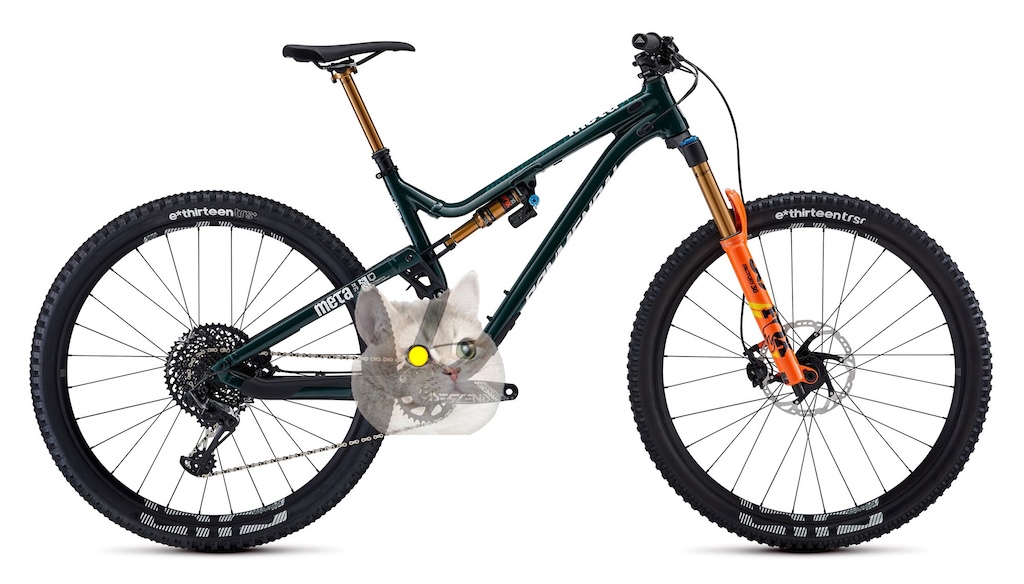
Given that the Meta TR 29 is a single pivot design the instant center, IC, is the main pivot. Depicted here by the engineering standard for showing an instant center - a cat.
The Commencal Meta TR 29 is, as the name suggests, a 29” wheeled bike with 130mm rear travel and a 150mm travel fork. It was recently reviewed by both the Mikes during the Sedona Field Trip.
It uses a single pivot suspension system to define the axle path and acceleration responses of the bike, and the seat stays, link and shock extender to compress the shock.
Most of Commencal’s less gravity orientated bikes use this same system, with only the Clash and Supreme using other linkage arrangements. One thing that is true of all the Commencal bikes is that they’re single pivot.
It uses a single pivot suspension system to define the axle path and acceleration responses of the bike, and the seat stays, link and shock extender to compress the shock.
Most of Commencal’s less gravity orientated bikes use this same system, with only the Clash and Supreme using other linkage arrangements. One thing that is true of all the Commencal bikes is that they’re single pivot.
Commencal Meta TR 29 Analysis Details
Travel Rear: 129.7mm
Travel Front: 150mm
Wheel Size: 29"
Frame Size: M
CoG Height: 1100mm
Chainring Size: 32T
Cassette Cog Sizes: 50T, 24T and 10T
Travel Rear: 129.7mm
Travel Front: 150mm
Wheel Size: 29"
Frame Size: M
CoG Height: 1100mm
Chainring Size: 32T
Cassette Cog Sizes: 50T, 24T and 10T
With the relatively long link lengths between pivots we generally see some smooth curves being generated. The Meta TR 29 uses a 50mm stroke shock to get its travel, with all the bikes in the range using air shocks, although varying between Rock Shox and Fox units. All the shocks see standard eyelets with no trunnion mount being used. With the Commencal design already using a shock extender the shorter eye to eye from a trunnion shock would only make the shock extender longer and up the non-axial loading transferred into the shock.
As opposed to many of the bikes we looked at in the endure category, the Meta TR 29 has no adjustability. In fact, none of the bikes in the trail category have adjustability. While this made my life a little easier for the analysis, and your lives a little easier with less curves on graphs, it also might say quite a bit about the trail bike’s intention to just be grabbed from the garage and ridden, rather than tweaked and tinkered like their longer travel variants.
Commencal also represents a direct to consumer brand, which often sees large differences in price to similarly specced bikes from more dealer-based brands. While there are downsides to this business model, it’s interesting to note that the price reduction shouldn’t necessarily yield a reduction in suspension performance. For the most part, pivot point position, which leads to the kinematic curves we see below, isn’t solely tied to price. Some of the bikes we will look at in the coming weeks have unique suspension parts, which would add cost to the bike. But there’s no substitute to getting the pivot points in the right place and paying $2,600 for a bike, like the Meta TR 29 29 Ride, shouldn’t mean your suspension performs terribly.
Leverage Ratio
The Meta TR 29 has 14.63% progression with a starting leverage ratio of 2.87 and finishing at 2.45. For the whole leverage ratio curve there’s an average ratio of 2.59.
For our five trail bikes the Commencal comes in close to the least progressive bike. But in comparison to other single pivot bikes, where progression percentages can be under 1%, it does have a decent dollop of progression.
From the Field trip test, Mike Levy found options in setting the sag at 25%, 30% and 35% shock stroke, resulting in 26.75%, 31.91% and 37.01% of rear wheel travel sag respectively. The Meta doesn’t have a crazy high progressive leverage ratio curve and sees its shock sag followed within 2% by the rear wheel sag it produces. Some highly progressive bikes would see that rear wheel sag percentage vary by 4%, meaning the bike would be sat further in the rear wheel travel with slightly less available positive travel.
The leverage ratio curve is parabolic. It starts with a steeper gradient curve and flattens off towards the end of travel. If we differentiate the leverage ratio curve then we can see a straight, but rising curve that indicates the presence of a parabolic, x^2, shaped curve in the leverage ratio.
While I’m a fan of leverage ratios with as straight a line as possible (progressive but no roller coaster business in between), this curve would work well with the air shocks that the bike is specced with throughout the range and their inherent ramp up at the end of travel.
Despite the general parabolic shape, there aren’t any wild humps or rapid changes. This is a common curve shape, often seen in some rocker pivot Horst link bikes, and seems to play well with predictability and shock setup as the main portion of travel is smoothly chaining and only the end portion could need adjusting with volume spacers, which are an easy thing for everyone to play with.
The leverage ratios are on the lower side of things when compared to many other highly leveraged trail bikes of today. The lower leverage ratios would reduce the amount of air pressure needed to achieve a certain sag, reduce the overall amount of force being transmitted to the shock, pivots and frame members and also generate more damping force in the shock due to moving it faster than a highly leveraged bike. The Meta TR 29 should sit in a nice window of balance between spring rate forces and damping forces.
Supportive, predictable and composed were used to describe the Meta TR 29s descending capabilities during the Field Trip. That is in part due to that lower and smoother leverage ratio giving ample support from the balance of spring and damping and no nasty surprises thrown up as the bike compresses and rebounds through its travel.
Anti-Squat
The Meta TR 29 is specced with a 32-tooth chainring and SRAM Eagle gearing.
All gears produce high values of anti-squat. The single pivot layout means the transitions from start to end of travel are smooth without huge drop offs in percentage. There’s even a convergence point of all the gears close to the end of travel.
Taking a sag of 30% shock travel, the lightest climbing gear sits at 97%, with a drop down in the percentages if you were to encounter bumps while pedalling or have your body weight push the bike into its travel.
This goes a long way to combatting suspension squat from load transfer. Other movements and inputs during pedalling, from your upper body and legs, could have some suspension compression, but the combination with the lower leverage ratios and progression should provide a supportive response when you’re out and pedalling around.
As the gears get harder the anti-squat rises. Mid cassette range there’s around a 6% rise in anti-squat at sag to 103%. But the hardest gear sees more of a jump in the anti-squat, to around 116% at sag.
As both Mikes commented from their Field Trip, the Meta TR 29 climbs extremely well and felt supportive due to that combination of high anti-squat, lower leverage ratios and good seat position geometry. They even reported that there was no need for the climb switch on the shock due to how well it climbed.
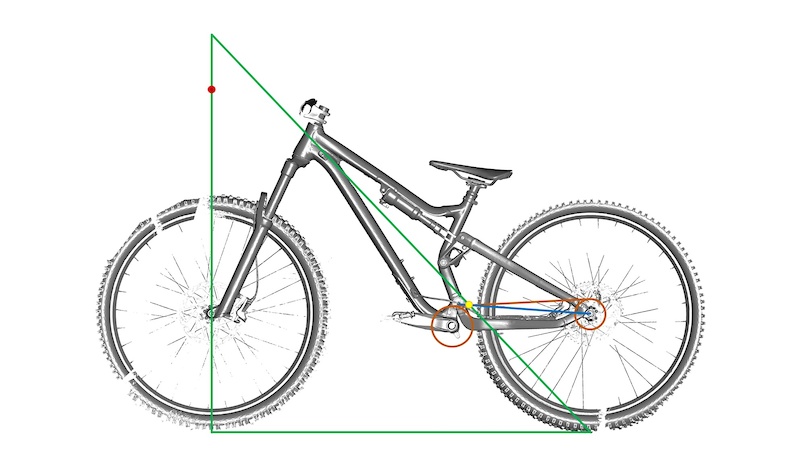
0% Loaded
1/21
Cycling the bike through its travel we can see how the anti-squat decreases with travel. This is with a 24-tooth cassette gear. The red dot shows the 100% anti-squat point and the yellow dot shows the instant center of anti-squat.
Pedal Kickback
Higher anti-squat percentages with the single pivot design mean that there is more pedal kickback than if that anti-squat percentage we’re to be achieved with a design that has a virtual instant center. The single pivot design has a fixed IC at the main pivot, with little room to move fore and aft in comparison to a virtual IC from a four bar or short link bike.
The maximum amount of pedal kickback in the lightest 50-tooth gear is 26.9°. This then drops to 13.4° in a 24-tooth cog and down to 6.2° in the 10-tooth.
In an effort to put these pedal kickback figures into a more real-world scenario, rather than just on a graph, we can set up a real-life obstacle and see how fast the bikes we analyse would need to be travelling forwards to avoid any pedal kickback whatsoever. We can set a few parameters and compare the bikes over the coming weeks.
If we were riding along in the 24-tooth gear on the cassette and then rode off a 1m high drop that used 75% of our travel, how fast would we have to be going for the impact to not cause any pedal kickback? We don’t need to look at points of engagement in the hub, as we’re only interested in at above what bike speed the impact would never cause the freehub to catch up to the hub body.
In the case of the Commencal, we’d have to be going 9.9km/h, or 6.2mph, for the pedal kickback to never be a problem.
If we were in a harder gear, this limit speed would decrease and if we were in an easier gear then it would increase. The change in speed would also reflect the change in pedal kickback from that gear combination.
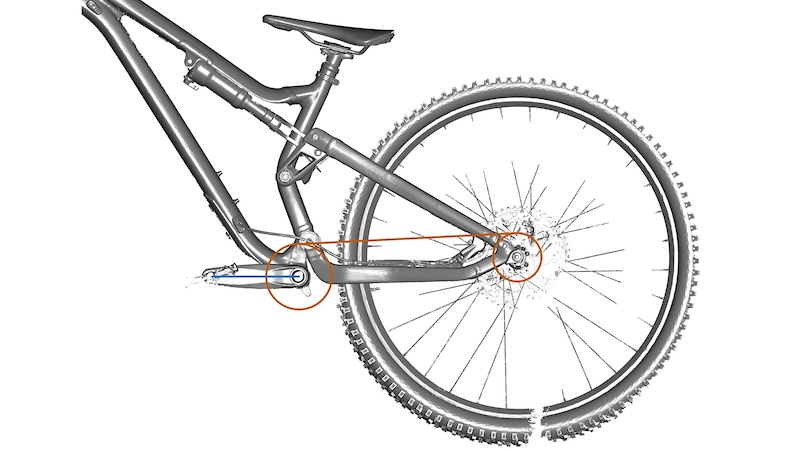
0% Loaded
1/21
We can also see how the pedal kickback with a fixed rear wheel and a 24-tooth cassette gear works. The green line that remains is the 0 degree mark.
Anti-Rise
The single pivot design with its relatively high anti-squat also means that the anti-rise figures are pushed up too. At that same 30% sag the anti-rise is bang on 100% and the curve shape follows the same trend as the anti-squat with close to a straight line and a small drop off as you go through the travel, finishing at 85%.
With that 100% anti-rise at sag there should be no rising of the suspension due to the load transfer from braking with the rear brake only, and as the bike goes deeper into its travel there will be some rising of the suspension due to this load transfer as the percentages drop under 100%.
These higher percentages will usually translate to the bike staying closer to its optimal geometry rather than extending and potentially upsetting the balance of the bike and rider. But remember, anti-rise is only one fragment of explaining how a bike will perform under braking.

0% Loaded
1/21
Cycling the bike through its travel we can also get a better idea for the anti-rise. The red dot shows the 100% anti-rise point and the yellow dot shows the instant center of the bike, or in this case, the main pivot.
Axle Path
Looking at the main pivot height of the Commencal, it’s pretty much bang on chain line with the 32-tooth chainring, and so contributes to the relatively high levels of anti-squat and anti-rise with this greater distance from the bottom bracket. In comparison to a true high pivot bike the main pivot is fairly low and this can be seen in the axle path.
There is a small amount of rearwards movement to just before sag, just over 1mm. But from then on, it’s a forward’s trajectory for 11.8mm until bottom out.
The Meta TR 29 is designed to be a trail bike, and to do that they have had to really balance all the qualities of the bike. Some of the high pivot bikes out there are a bit more aimed at the downwards side of the hill, and their drastically more rearward axle paths show this. But the Commencal has struck a good balance all through the bike with the geometry, suspension characteristics and even spec. So, the axle path would be more of a result of balancing all these other factors rather than the clear driver for the bike’s direction on, for example, the Forbidden Druid and Deviate Highlander.
Assumptions in Analysis
For all the trail bikes we took size M, and so we adjust our Center of Gravity (CoG) height to 1100mm above the ground.
It’s good to remember that the analyses for anti-squat and anti-rise always assume a static CoG. In the real world this is rarely the case, but needs to be done for analysis’ sake to allow it to be easily calculated and then compared to other designs and bikes. Once we have our analysis it’s then easy to add back in the real-world elements that are relevant to each of us and where we ride our bikes. For more chin scratching about that check out the Enginerding article on anti-squat.
There’s no industry standard for the fork in anti-squat and anti-rise analysis. We can either fix the fork travel to generate a single curve or we can adjust the fork travel as we go through the rear travel to create a window. For these analyses we leave the fork at fixed at full travel. Again, as long as these assumptions about AS and AR are known and understood, it’s easier to analyse and compare bikes.
Final Thoughts
Author Info:
Must Read This Week
[UPDATED] Final Elite XC Results & Overall Standings from the Mairiporã XC World Cup 2024
42185 views
42185 views
Sign Up for the Pinkbike Newsletter - All the Biggest, Most Interesting Stories in your Inbox
PB Newsletter Signup
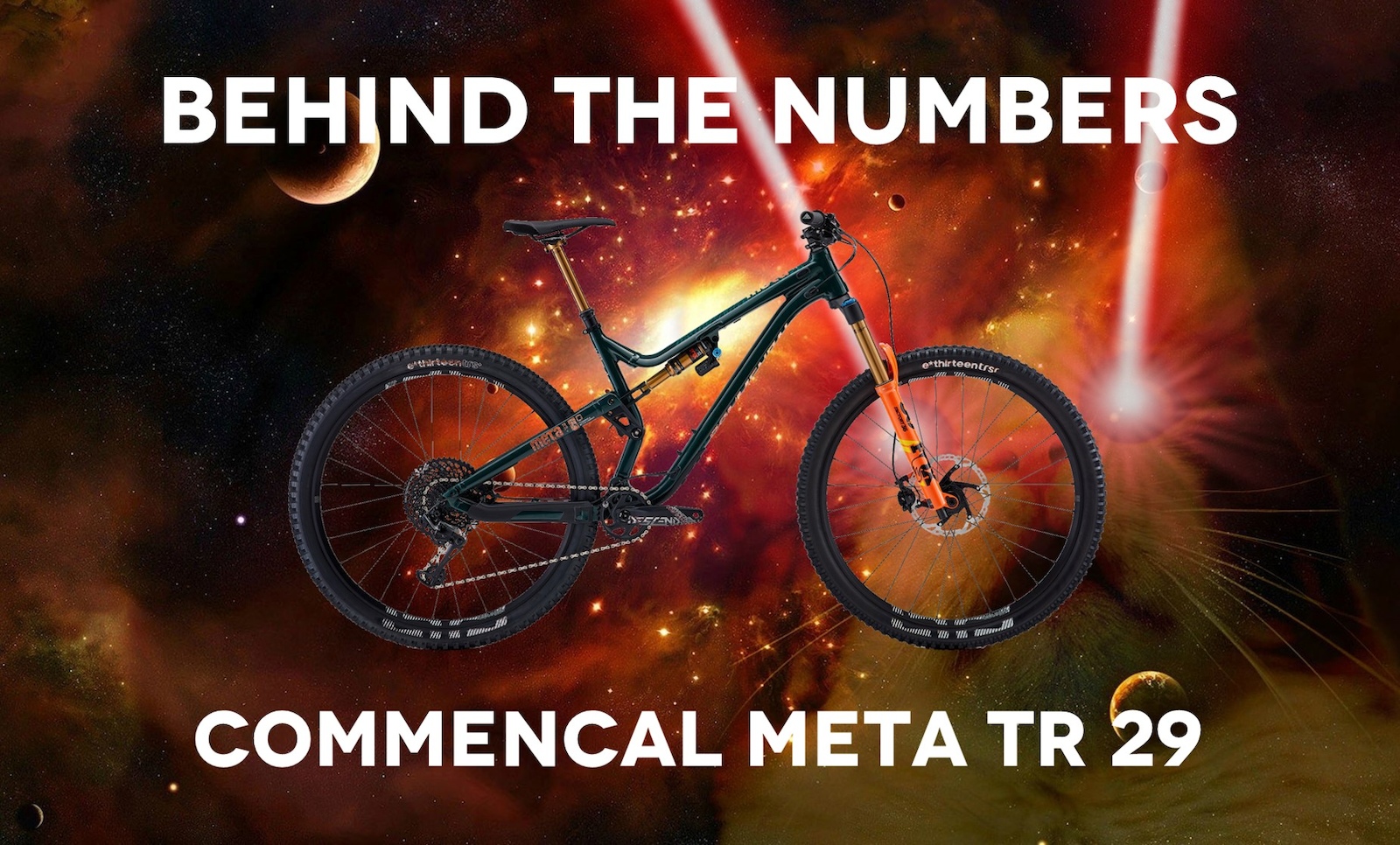



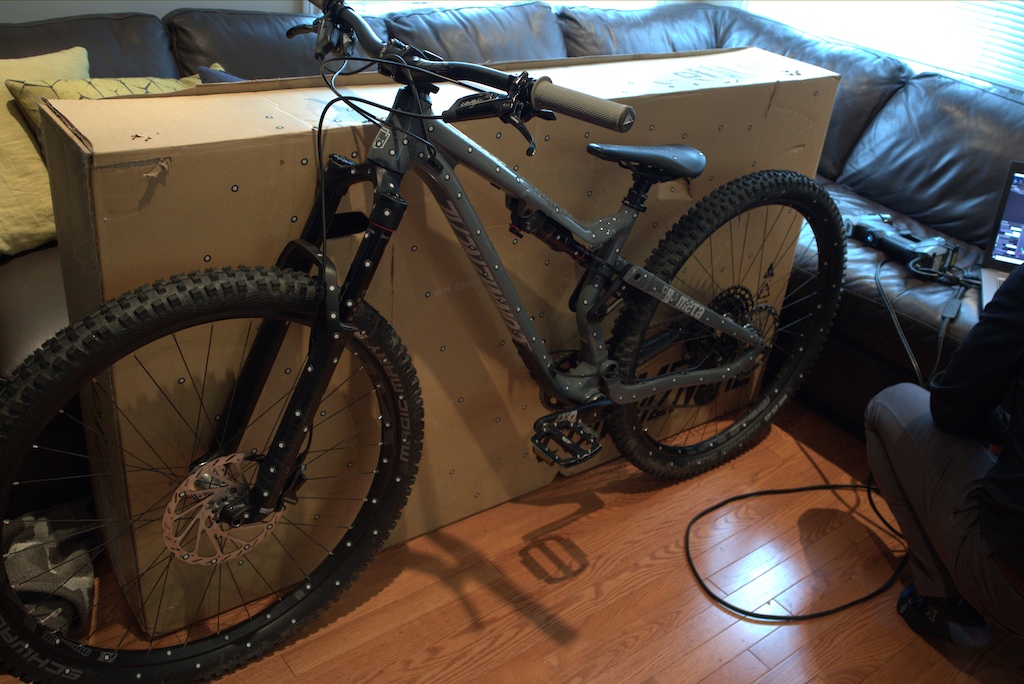
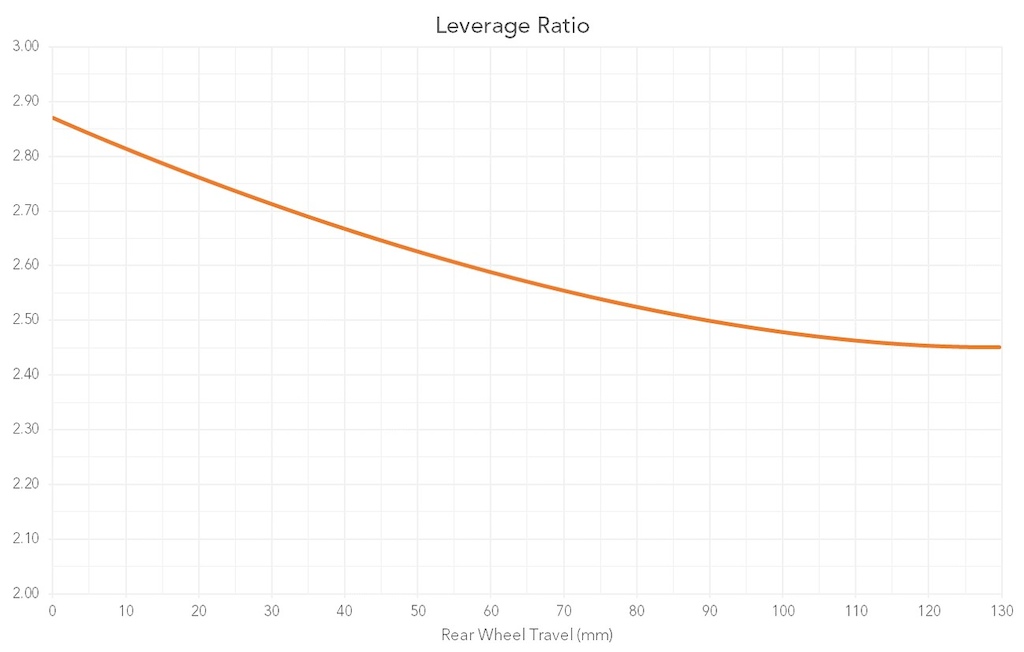



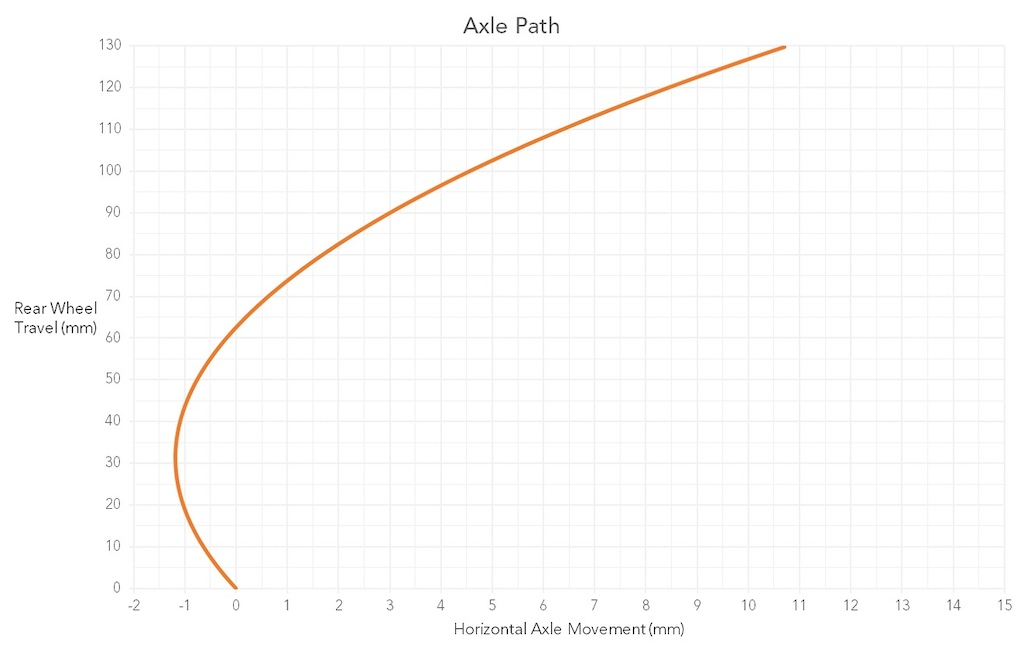
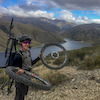
Recently tried some tech stuff and as my butt's shape matches tire perfectly, I do not find it pleasant
tech.commencal.com/bike/META-TRAIL-V4.2-ESSENTIAL-650B--SHINY-RED-2018/293.html
Now, those 26" bikes are worth approximately $300 max cause nobody wants an outdated standard.
So what do you think is gonna happen with 27.5 in a few years?
Sure, you will still be able to buy 27.5 wheels, just like you can 26 wheels, but you see companies every year drop their 27.5 lineup in favor of full 29. This trend is going to continue.
And if you think that simply putting on 27.5 wheels on a 29er is magically going to make the bike better handling, you don't really understand the purpose of smaller wheels. Its not about the wheel size, its about how much clearance you have, so 27.5 allows for more compact bike, just like 26 allows for a compact dirt jumper. If you have a 29er bike to start with, 27.5 wheels will just make the BB lower leading to more pedal strikes and require more lean to make the same corner.
Even if I could get used to a 29er I really like my 27.5 and will be annoyed when I have to change because manufacturers dictate it. Just like I'm going to be annoyed when I can no longer get 11 speed parts.
Hrrumph
So yeah, 27.5 isn’t going anywhere, mostly because people are beginning to realize that 29” wheels aren’t best for everything; the crowd grows restless.
I’m really glad you like 29” wheels, good for you!
But really, is your penis so small that you have to dump on other peoples rides to make yours look better?
Get a life son!
If you're actually a nurse I hope you just had a long day and already used up all of your compassion at work.
BB height from the ground is a function of design, not wheel size. You can make a high bb 29er or a low bb 27.5 or vice versa.
>Even if I could get used to a 29er I really like my 27.5 and will be annoyed when I have to change because manufacturers dictate it.
Cool, except the vast majority of the riders literally got used to 27.5 a few years ago and nobody is saying old 26"s are better.
>mostly because people are beginning to realize that 29” wheels aren’t best for everything
Go back five years, and you will hear similar arguments. "People are beginning to realize that 27.5 wheels aren't best for everything"
Same shit today with 27.5 vs 29. Not sure why this is so hard to understand. Whatever arguments you have in favor of 27.5, it was the same arguments for 26 vs 27.5, but I bet you won't buy a 26 bike these days.
Literally nobody cares. I dgaf about what you can or cannot do on a bike, the discussion is not about 360s, its about wheel size going forward in the future. Whether or not you are going to be riding 26 wheels won't matter when the only freeride frame you can get will be in 29.
26 DJ and slopestyle bikes are going to exist for sure. For things like freeride, which are dominated by long travel DH bikes, you aren't going have people making 27.5 DH frames, just like nobody is making 26 DH frames currently even though they are better for tricks. You will have to go with custom builds just like all the other people are doing now.
The axle path plots are misleading, if the x and y axis were scaled 1:1 - it would be a near vertical straight line. I understand you're trying to show differences between suspension designs, but this seems to overstate this particular metric.
We saw this entering the MTB jargon and people obsessing with it while look at charts that amplify the actual axle path
www.pinkbike.com/news/first-ride-the-2020-specialized-enduro-is-bigger-and-burlier-than-ever.html
- Switch infinity = achieves a similar more desirable wheelpath like multi-link using a fancy slider system, no real benefits over multi-link
- high pivot = gives lots of rearward wheelpath, moreso than multi link designs, requires complex and draggy pulleys
- Dw-link = uses linkages to modify wheel path, shock ratio and incorporate a break-arm element into the linkage, difficult to optimise and tune shocks to
- ABP = Uses a pivot so the seat stay can act as a break-arm, just a way around the Horst patent with added complexity
- FSR = basically just single pivot but uses the seat stay as a break-arm, has a less rearward wheel path than single pivot
... the list goes on
But, still, 99% is the rider. The harder/better you ride, the less it matters. That's why you can see so many different opinions on single pivot vs virtual.
For me, a benefit of single pivot was that it made me NOT brake in stupid moments which made me actually faster.
The purpose of the second link is to be able to tune the shock leverage curve separately from the brake squat and pedaling anti-squat.
It's kinda like skiing, you can be a full tech nerd on improvements in various aspects of ski design. But bottom line, technological improvements only go so far, if you want to be a better skier, you need to physically work on being a better skier and quit trying to use technology to make up for your weaknesses as a skier.
I always find Giant Maestro, FSR or Single Pivot bikes to feel the best for chucking into rock gardens with no bouncing around whatsoever. But I don't know why that is. Can any design do that, and it's more about the pivot points and kinematics?
Highly progressive motion ratios tend to be plush, especially with a high average leverage ratio and/or light damping tune. This won't be the most controlled set-up, just as a plush car bounces and wallows, but it should feel soft and squishy.
Other than that, start with a coil shock first. One of the most crucial aspects in terms of the effect of the actual linkage design is having rearward wheel travel for better roll over, meastro actually has a pretty high virtual pivot point, so a fair amount of rear axle path compared to most faux bar/horst/fsr set-ups.
A more linear progression rate, like a coil offers, will help with repeated big hit compliance throughout the full range of travel
These days bike suspension feels remarkably similar across many platforms since they are mostly competently designed, or at least have similar design goals based around objective kinematic performance.
As an aside: people that follow objective audio performance can see the same type of silliness employed to more absurd degrees.
I’m pretty sure Max Commencal and his like 6 racing teams know something about R&D.
(as you know) Fork compression shrinks the wheelbase by sFork*cos(HA), which turns out to be a not huge amount relative to the wheelbase. This shrinking wheelbase means more load transfer (so lower anti-squat %). nothing more than 10% in my experience and is basically the same for different bikes.
It's completely linear as you go from 0->100 too, because sFork*cos(HA) is linear for a constant HA. I normally don't even bother especially when you also want to plot 2 flip chip positions * 2 chain-stay lengths * 3 chainring sizes * 5 different frame sizes... just looks like vomit on the figure window
MY main beef with the way anti-squat is presented in this series is that CG location is the same for all bikes. Especially for e-bikes, the increased bike mass brings the CG down a lot for the 50lb ones with light riders. We don't NEED to assume a set, static value to make comparisons fair!!! We just need a standard process for determining CG height as a function of riding position, bike weight distribution, rider weight distribution, and bike size. It's painfully obvious that a 6'6" 250lb guy on a XXL won't have the same CG height as a 5'0" 100lb gal on a XS! Would be nice to let the tall/short guys know which bikes may be worse/better for them. From what I've seen, most brands design kinematics around a medium or large.
Only answer to this is size specific kinematics... which makes the bikes even more expensive... and my wallet is already empty :-(
My full-sus is now an ebike (I have a 150mm hardtail for when I want a simple life) and with that the difference in antisquat between motor off and motor at max is very obvious. Even when I’m pedalling at my hardest the extra chain tension if the motor is in turbo means it doesn’t bob at all. But pedal as hard without assistance and it bobs quite a lot. It would be nice to be able to up the anti-squat when I’m choosing to ride it like a normal bike!
Who cares? No one is pedaling at 85% of the way to bottom out, if you could even get a full crank in without hitting the ground.
“ In the case of the Commencal, we’d have to be going 35km/h, or 21.9mph, for the pedal kickback to never be a problem.
If we were in a harder gear, this limit speed would decrease and if we were in an easier gear then it would increase. ”
Kickback does occur when pedaling, but it doesn't spin the cranks backwards, it just slows their rotation for a moment. This feels a bit like rearward motion, but it's not.
Broadly speaking, kickback is minimized with low anti-squat (squishy pedaling) and less travel. The latter may won't help your ankle situation, so there's more to it than just minimizing kickback, especially since kickback rarely occurs at all and almost never occurs to anywhere near the extent shown in the animation.
The Bike just different & needs more time to get used too, or just use what you are comfortable with !
This is where the real world comes in. Max pedal kickback happens in lower gears, where you notice it the least. Full travel generally happens at higher speeds and higher gears. This 3 factors together make pedal kickback less relevant than some people think.
Someone somewhere else made the math for the Specialized Enduro. The bike was nearly universally praised for being a rock garden eater but has relatively high pedal kickback values. This alone should have raised some eyebrows of people who obsess about this value. So, math done, it happens that, roughly speaking, they about mid-cassette Enduro's kickback value of 30° only becomes to be noticeable at full travel usage under 28km/h
The conclusion here is not that pedal kickback doesn't exist, it obviously does, but rather that it's effects are often misunderstood and overblown
But maybe there are other things than just pedal kickback to consider with softening the blow for a dodgy ankle.
In other words, if bike speed is such that the freehub allows for a speed at the selected cod teeth that is greater than the speed at the chainring teeth created by the suspension compression, then no pedal kickback occurs.
You used a very specific name for something you feel, pedal kickback. That term describes a specific behavior that is described by objective factors. Speed happens to be 1 of them.
If you said something like "suspension harshness can happen at all situations regardless of speed" then I would have to agree with you, as this harshness can com from a number of factors and phenomenons other than pedal kickback
www.pinkbike.com/u/R-M-R/album/Tech--nerdy-stuff
• Find the instant centre. For a single-pivot, it's the main pivot; in this case, it's obviously the centre of the BB.
• Create the virtual (or instant) swingarm by connecting the rear axle with the instant centre. Extend this line as needed.
• Extend the line of force in the drivetrain (the upper run of the chain) until it crosses the virtual swingarm.
I trust you can take it from there. Refer to Dan's Enginerding article for additional words and images: www.pinkbike.com/news/definitions-what-is-anti-squat.html
Notice that when the Fundy's front and rear sprockets are the same size, the chain is parallel to the swingarm. This produces zero anti-squat throughout the range of travel. If you set up your Fundy as a 1:1 singlespeed, you will have a true zero anti-squat bike. Why you would want such a thing is another matter ...
For a given wheel size and chainstay length, the pedaling anti-squat indicates the axle path at that point in the travel, so anti-squat is related to axle path, but not leverage curve.
Even then, there are many other rear world factors that can come into play, for example where you have your center of gravity on a bike, the landing, and even things like how much one did/didn't preload a big jump, etc. You'd have to compare 2 bikes with exact similar geometry, set up the "same" on the same exact jump/hits to attempt to make a comparison between 2 different bikes when it comes to pedal kickback differences in the real world. I doubt there are many who've actually done that.
The Stumpjumpers clear 52,5 or 55mm depending on the mode/ size
Generate more damping force in the shock? The shock generates the damping force...
And it would be moving slower in a lower leverage bike. LR of 2 for 130mm travel is moving the shock 65mm to bottom out, where LR of 3 for 130mm would move the shock 43.3 mm to bottom out. So lower ratio moves the shock further to move the wheel out of the way the same amount. More distance to go in the same time means faster speed on the lower ratio.